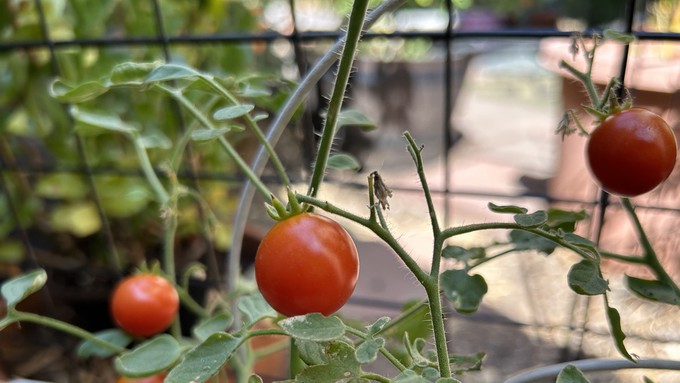
Red Flag Warning means be cautious; what Sacramento-area gardeners need to know

With smoke in the air, be sure to wash particulate dust off any produce before consuming it -- including those snack-perfect cherry tomatoes. Kathy Morrison
We’re in the midst of California fire season. If you need any reminders, just go outside.
Hazy skies are due to smoke from six major wildfires burning in Northern California plus more in southern Oregon. The closest blaze is more than 200 miles away, but the smoke is funneling into the Sacramento Valley and floating our way.
And we’re surrounded by potential fire danger. Due to our wet winter, there’s an abundance of plant material throughout our region. Recent triple-digit weather dried annual weeds and grasses tinder-crisp. That’s fuel for hungry wildfire.
“A Red Flag Warning remains in effect through 8 PM today for portions of the Sacramento Valley,” tweeted the NWS Sacramento office on Wednesday morning. “Breezy winds & very dry conditions will create critical fire weather conditions. Be sure to use extra caution if using outdoor equipment and keep vehicles off of dry grass!”
In the afternoon, winds will push some of the haze out of the Sacramento area, but we can’t breathe easier.
“The smoke and haze present across much of the Valley this morning will diminish briefly this afternoon,” says the weather service. “However, we're expecting haze/smoke to return overnight and into Thursday morning.”
To check your local air quality, go to: http://airnow.gov
Low humidity, gusty winds and plenty of dry fuel can be a recipe for catastrophe. On Wednesday, humidity levels will dip down to 5 to 17% with wind gusts of up to 35 mph, says the weather service.
“Fire safety should be exercised to prevent fires,” it adds. “Always have an emergency plan if a fire starts near you.”
All it takes is a spark. A metal blade of a lawnmower or trimmer against a rock can ignite dry grass. A vehicle parked on dry grass or weeds can start a fire, too. So can a chain dragging from the back of a trailer. Use extra caution.
As for the hazy skies, tomatoes, peppers and other ripening vegetables could be dusted with fine particulate matter. Make sure to wash anything you harvest before eating. (No backyard cherry tomato-munching right off the vine.)
Spider mites love these dry, hazy, dusty conditions. Take out the hose and give your tomato vines and rose bushes a morning shower; that will knock mites off and refresh plants.
So far, there hasn’t been enough smoke in our area to worry about smoke taint, the absorption of smoke flavors through the skin of ripening fruit. But that could be an issue for grape and fruit growers closer to the fires in Trinity, Humboldt and Siskiyou.
As we know from fire seasons past, conditions can change dramatically in a hurry. It’s better to be prepared.
For tips: https://www.readyforwildfire.org/.
Comments
0 comments have been posted.Sacramento Digs Gardening to your inbox.
Sites We Like
Garden Checklist for week of July 21
Your garden needs you!
* Keep your vegetable garden watered, mulched and weeded. Water before 8 a.m. to reduce the chance of fungal infection and to conserve moisture.
* Feed vegetable plants bone meal, rock phosphate or other fertilizers high in phosphate to stimulate more blooms and fruiting. (But wait until daily high temperatures drop out of the 100s.)
* Don’t let tomatoes wilt or dry out completely. Give tomatoes a deep watering two to three times a week.
* Harvest vegetables promptly to encourage plants to produce more. Squash especially tends to grow rapidly in hot weather. Keep an eye on zucchini.
* Pinch back chrysanthemums for bushy plants and more flowers in September.
* Remove spent flowers from roses, daylilies and other bloomers as they finish flowering.
* Pinch off blooms from basil so the plant will grow more leaves.
* Cut back lavender after flowering to promote a second bloom.
* It's not too late to add a splash of color. Plant petunias, snapdragons, zinnias and marigolds.
* From seed, plant corn, pumpkins, radishes, winter squash and sunflowers.